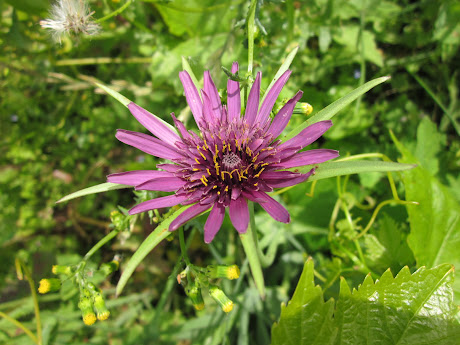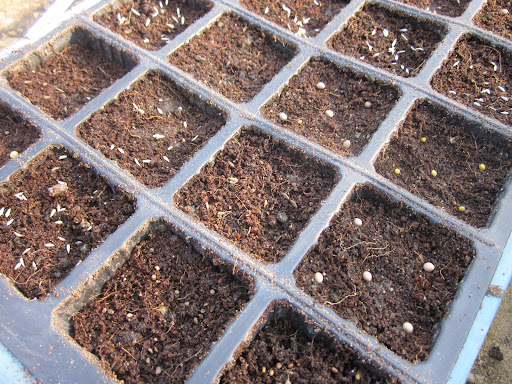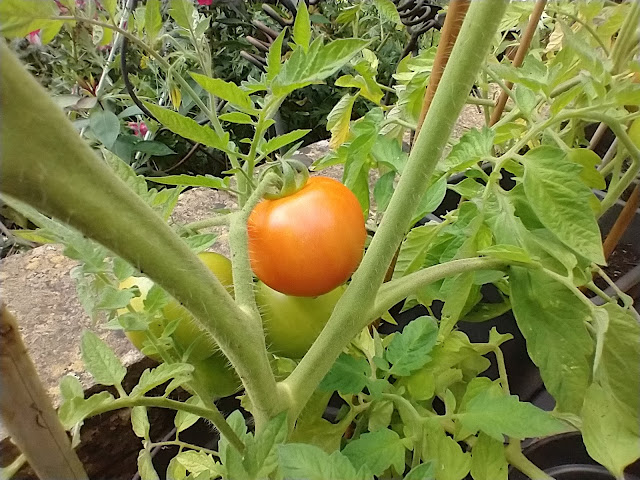Hairy Bittercress: The 30 Day Challenge
My garden's overrun with hairy bittercress this year. It even greets us by the front door when we arrive home. How did it happen? I'm sure it's because the latest specimens are tiny and almost unnoticeable. When I find them it's almost too late. Their seeds sproing everywhere when picked, their spread is relentless.
My usual solution to this problem is to add them to our salads. They're edible, so what could be a better revenge than to eat our weeds? Sadly, the latest specimens are too small; there's as much cardboard-like seed bearing stalk as edible basal rosette. They're not enough of a tasty morsel to include in our dinner.
I fear I may have helped with this plant's natural selection. By weeding out the more noticeable, normal sized specimens, I've allowed the smaller, almost unnoticeable ones to take hold. In some cases, I only spot them when the seed heads poke their noses above the patio. You have to admire that tenacity for survival, even if it gives this gardener a bit of a headache.
I've looked to see if my observations are rooted in scientific fact, sadly to no avail as yet. However, I did find an interesting study from Clemson University, which investigated its seed production, dispersal and control in propagation beds.
In some ways it's the perfect weed. Seed production is year-round; each plant can produce thousands of seeds; germination rates are high, its explosive dispersal mechanism spreads seeds far and wide, and the seeds themselves are sticky. My admiration increased.
I was also a little daunted, but then I spotted a potential chink in the armour. The study found 90% of the seed germinates in 13 days, so if I'm like Mad-Eye Moody and employ Constant Vigilance, I have a good chance of gaining control over my garden's population.
I'm going out every evening on a bittercress hunt and I weed out any culprits I find. Each one is removed carefully, so any seed dispersal activity is minimised. I'll keep this going for a month, which allows some extra time for the other 10% to make their appearance and to round up any scattered offspring.
Wish me luck.











What an interesting post. I have lots of it here too, at home and at the allotment. I didn't know what it was called, but it's very persistent. It stays low and sneaky and as you say, there are seed pods almost before you realise it's there. I'll look forward to seeing how you get on eradicating it.
ReplyDeleteYes, CJ it is very sneaky. I'm sure those seed pods pop up when I'm not looking.
ReplyDeleteWe have loads of it here too but I don't think we would enjoy eating it somehow, it would be another to add to the undergardener's list of rabbit food!
ReplyDeleteIt lives up to its name Pauline, you only need a little in your salad ;)
DeleteHateful stuff, that Hairy Bittercress. It is good that it appears early in Spring and is soon gone, leaving us to worry about when we'll see Chamberbitter in late summer. Both plants have that annoying way of spreading seeds everywhere.
ReplyDeleteIt's a year-rounder in my part of the UK, Jean. Now I must find out what Chamberbitter is, it doesn't sound good!
DeleteI've just looked it up. Looks pretty as a seedling (like a Mimosa) but I see Clemson rate it as a weed that's difficult to eradicate :(
Deletehttps://www.clemson.edu/extension/hgic/pests/weeds/hgic2314.html
I don't mind it that much. It helps cover the soil, which I think is good. Must remember to eat it, though! Do you think your plants might be a bit stunted because of the lack of rain this month?
ReplyDeleteGood point re the lack of rain, but I also had a conversation with Tom Mitchell at Evolution Plants last year, re us selecting for smaller plants. I must ask Tom if he has a reference I can look up the next time I see him.
DeleteIt's a very determined weed isn't it?
ReplyDeleteVery!
Deletethat's fascinating about the germination rates... you are inspiring me to have a similar purge!
ReplyDeleteThat's great :)
DeleteThat is one tough weed, that seems to seed quickly and sneakily. Hope you get them all!
ReplyDeleteI suspect I won't get them all, but I'm aiming to get the problem down to more a manageable level at least!
DeleteI just like name.
ReplyDeleteI like the latin name too - Cardamine hirsuta - hirsuta means hairy.
DeleteGood luck and let us know if you are successful!
ReplyDeleteThanks Carol!
DeleteIf I tried the purge thing in my garden I'd never do anything else… (droops shoulders). Maybe the best approach is to do the obvious parts, but my goodness it's a 2@@™&**!!!!!….
ReplyDeleteFor once I'm pleased my garden's relatively small Kate, otherwise my shoulders would droop too.
DeleteGood luck VP. It's one I keep a close eye on and I do my best to never let it get to flowering stage. However, I think the wind has been it's friend this year and no matter how viligant we are, I suspect more seeds come into our gardens via the wind. Naughty wind.
ReplyDeleteI think quite a bit comes in via wildlife too, Gwenfar owing to the sticky seed. You have to admire how well adapted this plant is for survival, even if it's annoying!
DeleteOh, is that what that is?!
ReplyDeleteIt is all over our new garden too. I don't mind it too much as it comes out easily enough, it's the weeds with deep roots which are a problem for me.
It's interesting how many of our common weeds are edible - dandelion, for instance, and horsetail. I wonder if they are so common now simply because most people have stopped eating them?!
That's food for thought Juliet ;)
DeleteTouch wood, I haven't suffered too badly this year. I mean, yes, there has been lots growing but I've been plucking out weeds almost before they start this year. I might change my name to Constant Vigilance, it has a nice ring to it … like Ford Prefect. :) xx
ReplyDeleteHow about Constance Vigilance - sounds like a good name for a garden blogger ;)
DeleteIt's worked pretty well - there's just a small, tenacious pocket left in the big rose pot on the patio. I'm keeping my Mad-Eye trained in that area to look for escapees ;)
ReplyDelete